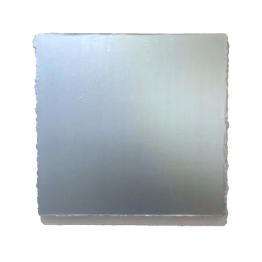Bernard Aubertin, born in 1934 in Fontenay-aux-Roses, France, was a French artist. As one of the key figures of group ZERO, Aubertin shared new ideas and artistic practices with his contemporaries and consistently explored the materiality of paintings through colors and mediums.
Aubertin’s red monochrome paintings, begun in 1958, are the most representative works from the past 60 years of his life as an artist. They are also considered one of the greatest outputs of his artistic approaches and exploration. Early in his career, a meeting with Yves Klein in 1957 inspired Aubertin to use a single color to evoke a sense of materiality and spirituality without any illusionistic elements or verbal formulations. Soon, Aubertin found that monochrome painting neutralized figurative elements, such as lines, forms, and structures, and revealed the unique, essential aspects of pure painting. A single color maintained the “true value” of color, Aubertin believed that this value could be realized absolutely only by monochrome paintings. Therefore, choosing the color was very important to the artists. For him, color cannot be determined by any kinds of objective description, such as “blue like blue sky.” Instead, color should play an emotional role for allowing time to refigure one’s existence. For Aubertin, the color that does this is red. He explained that “red evidently provokes abstract emotions inherent in its dynamic radiance” and he emphasized the psychological aspect of color in the way of red spreads. In his belief, red exposed not only the “true value” of color itself but also the pure energy of painting.
“Fire” also plays a pivotal role in the artist’s oeuvre. In 1960, Aubertin applied fire as a medium which like the red paintings deliver physical effects. The artist’s fire paintings involve a strong aspect of performance because he invited spectators to see their process of making, in which he lit a fire directly on a metal surface with matches or on objects, such as violins and books. In this ephemeral process, he shows that the destructive matter of fire connotes both “creation” and “rebirth.” Two aluminium plate works “Tableau feu” (2009), are part of his early series of fire paintings. One is a perforated plate for matches, which the other one shows the burnt traces on the aluminum surface. Together, they reveal the coexistence of materiality and immateriality.
From his exploration of fire, Aubertin realized that colors black and red cannot be separated. He advanced his concept further in the creation “Monochrome rouge noir cachant A” in 1999. As the title indicates, a monochrome red surface is covered by black. “Monochrome noir cachant un monochrome rouge #3” (1999), also arises from the two colors’ hidden combination. This monochrome painting shows not only the artist’s unceasing research on colors but also the sternness of coloring on panel. In other examples of this work, he intensively applies layers of colors: 100 in “Monochrome rouge” and 60 in “Monochrome rouge noir.”
Aubertin’s approach recalls his “hidden desire” to define a new monochrome identity by painting “a unique picture made up of thousands and thousands layers of color.” Through his persistent research on paintings with repeated layers, he also stresses his intent to invite viewers to see the painting as an “incomplete picture” which his pictorial realization is not ended, so that having an infinitive possibility to continue and repeat his peformative attitude endlessly.

Exhibitions

Klaus Staudt – Light, space and movement
Klaus Staudt, born in 1932 in Otterndorf, is a German painter. He became known with his series of geometric reliefs. He lives and works in Frankfurt am Main.

